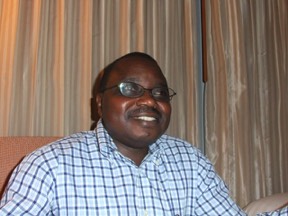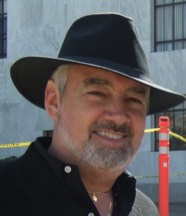Healing and Reconciliation:
Restorative Justice in Rwanda.
~ ~ ~ ~ ~
An Interview with Rev. Pius Naykayiro,
Rwanda Country Director of Good News Jail & Prison Ministry.


And Michael H. Fox
Japan Innocence & Death Penalty Center,
Hyogo University, Japan
The Newsletter of the Division of International Criminology
American Society of Criminology
Spring/Summer 201515
~~~~~~~~~~~~
In 1994, Rwanda was subsumed in genocide; in 100 days, close to a million people were killed. The genocide demonstrated the sudden ruthlessness that can inflame a nation, and the irresponsibility of the world community to respond to an international crime. "Restorative Justice" has become a goal in the alleviation of human conflict. A therapeutic bridge between perpetrator and victim, its potential rewards far exceed punishment and retribution.
Pius Naykayiro has spent most of the last two decades advancing the cause of restorative justice. He serves as the Rwanda director of the Good News Jail & Prison Ministry, a worldwide organization serving 22 US states and 26 countries (www.goodnewsjail.org). The organization's goal is to transform the hearts and minds of those behind bars, their families, and their victims.
Where were you when the hostilities started?
On April. 6th, I was on a bus bound for the airport to catch a flight to Nairobi in Kenya. While en route, the bus suddenly stopped, and the driver refused to go any farther. At this point, we all knew that hostilities had begun. I went to the home of an acquaintance. Everyone stayed indoors, nobody dared go out. I stayed in this small house with four people for two weeks with no showers, little water, and no food. At times, we could hear people being beaten to death. I never thought about hunger, only about survival.
What triggered the genocide?
The news that the president had died in a plane crash. Soon after, the media announced that the Rwanda Patriotic Front was invading to take over the country. We were advised, "Do not associate with the enemy." Riots began and the military began killing people indiscriminately. After two weeks, it became a full-fledged genocide.
Was the government responsible for the tragedy?
Absolutely. They planned and ignited the genocide. The Tutsis living in exile wanted to come back, and they had acquired important skills which could contribute to Rwandan development. But in 1990, not wanting to lose power, the government out rightly refused their return. At this time, we could feel a disaster brewing.
How does the reconciliation process work?
Typically, genocide perpetrators must acknowledge their responsibility, face the survivors, and ask for forgiveness. "I am the one who killed your siblings. Some I beat with a club. Others I sliced with a machete. The hacked bodies were buried in such and such a place." The perpetrators sometimes break down and cry, and kneel in forgiveness. One of the worst said "What I did was beyond being human. Kill me if you want." Now he is forgiven and lives with the victims in the same village.
Do all victims forgive?
Not everyone can, and some tell the perpetrators to leave and never come back. But the number of those who do forgive is very high, and the success has exceeded all my expectations. Repentance has power beyond what we can imagine. When perpetrators bow down in repentance, it has tremendous force. People cry together. This is the real healing of the hearts. And refusal to forgive today does not mean forever. Tomorrow may be bring new changes.
Will conciliation ever be completed?
Many people are indifferent to repentance and forgiveness. But the healing of the heart is a long process. It took 100 days to kill a million people, it has taken 20 years to rebuild our country. Over the past twenty years, we needed help from the world. But now Rwanda can be a model--a teacher of peace and justice-- to all the nations of the world.
Has the international community done enough in the aftermath?
The international governments should recognize their failure for not preventing the genocide. The UN Special Mission did nothing. Had they stepped in when dead bodies were being piled into rivers and lakes, the worst could have been averted. The Belgian military came to protect their own citizens. Belgium apologized, but not the UN. Kofi Anan, came to Rwanda, but never even attempted apology. Rwandan leaders refused to meet him, and he left the country in utter disgrace.
Were you accused?
Soldiers came into the small house where I took shelter. "What are you doing here? Do you think you are better than all those other people. Now, it is your turn to die." I knew that this was the end. I had some money in my pocket, and gave it to them, about $100. Their intention changed from murder to protection. I think God used the soldiers to save our lives.
Were you a victim of the violence?
One night, some guy, a complete stranger, started beating me. Having seen so many dead bodies, I thought this was the end. In the midst of the beating, I heard a voice, "Run, run!" Despite an aching body and dripping blood, I escaped to a banana plantation. It was really dangerous, dogs and hyenas were everywhere, wandering around eating dead bodies. The next morning, I was treated in a clinic.
And you later encountered the man who beat you?
Yes, he was discovered and brought before me. He acknowledged the beating. "What should be done to him?" I had no answer. He himself was beaten seriously by the soldiers. Though he knelt down and begged forgiveness, I just couldn't acquiesce. Three years later we met again by chance. At that time I was ready to forgive, but he chose to flee.
What became of your family?
Six weeks into the genocide, I decided to return to my village. Not only my house, but every house was empty. In all, I lost 11 family members. Two sisters were burnt alive. My brother, his wife, and four children were beaten to death. They were buried in mass graves.
Have you yourself made peace with the past?
After the tragedy, I was hopeless, angry. One day during prayers, I heard God's voice, "If you want to serve ME, You have to forgive THEM." One cannot serve God with anger or hatred. I never thought I could forgive those who made women into widows and children into orphans. But I have. Forgiveness is not easy, it requires hard work, and takes time. But it is possible.
What are children taught in school?
The genocide was a shame upon all of us. ALL Rwandans were affected and ALL must take part in conciliation. This must never be allowed to happen again. Being Rwandan is very valuable, above being Hutu or Tutsi. Therefore, we must continue to work for national unity.
How have people reacted to your lectures?
In 2008, I shared my testimony in Denver. A woman with a wounded heart stated, "I have a problem with your story of forgiveness." She didn't think Rwandans had a reason to forgive. "Why should you praise a God who has allowed your people and family to be slaughtered?" I responded, "Do you think God was good before the genocide?" She replied in the affirmative. I added, "And it was this same God who saved me from being killed."
GENOCIDE IN RWANDA
Chronology and Commentary (580 words)
~~~~~~~~~
Truth and Fallacy
In April of 1994, one of the worst genocides in world history occurred in Rwanda. Approximately 800,000 people out of a population of seven million were savagely murdered.
Much of what transpired in Rwanda has been attributed to ethnic conflict. But the notion of ethnic conflict is a fallacy. Rwandan society has long been composed of two historical occupational categories: cattle herders (Tutsi) and farmers (Hutus). Both groups are of identical genetic background and have long intermarried.
The simple categorization of a nation into two occupational fields is also misleading. As a modern and developing country, many Rwandans have long given up these occupations, and work in other fields, i.e., teachers, nurses, pastors, engineers, shop keepers, etc.
1994 Census Info
Tutsi (cattle herders) 14 %
Hutu (farmers) 85%
Twa (pygmy) 1%
Many were of mixed background.
Chronology of a Genocide
1885~1961: Colonial Period.
Both German and later Belgian colonists installed Tutsis into positions of governmental authority. They were considered "taller, honorable and eloquent." European scientists begin to study the differences among these groups to search for evidence of Tutsi superiority. None were ever found. These European sentiments catalyzed Tutsi pride and created vast hostility in Rwandan society.
1931. Belgians force the issuance of mandatory identity cards creating a major schism and malevolence between Tutsi and Hutu.
1959. Weakening colonial control allows Hutus to seize power. Civil violence occurs, many Tutsis are killed. As many as 300,000 flee the country, shrinking the already small minority.
1961 Rwanda gains independence. A Hutu president comes to power, and forces Rwanda’s Tutsi monarch into exile
1991 Tutsi refugees who have lived in exile since 1961 seek permission to return to Rwanda. Permission is denied. They form the Rwandan Patriotic Front (RPF), a rebel group, and attempt to invade. A ceasefire is declared and negotiations between the government and the RPF commence .
1993, August. President Habyarimana signs an agreement in Tanzania for a transition government which includes the RPF. This power-sharing agreement angers Hutu extremists.
1994 Genocide.
April 6. President Habyarimana, a Hutu moderate, along with Burundi president Ntaryamira, die when a small missile strikes their descending plane just outside Kigali airport. The perpetrators are believed to be radical Hutus attempting to seize control of the government.
April 7 Genocide begins.
April 21 After ten Belgian soldiers are executed, the U.N. reduces its force from 2,500 to 250 troops.
May 17 The U.N. agrees to send in 6,800 police officers, empowered to defend civilians, while the killings continues. The officers never arrive.
July. Hostilities end. Conservative estimates put the death toll at 800,000 --12 % of the country.
2003 A new constitution is enacted. Social classifications are outlawed.
~~~~~~~~~~~~
More than meets the Eye.
Other Causes for the Conflict
The Hutu-Tutsi animosity was not the only reason for the tragedy of 1994. Recent scholarship finds other causes, over-population, food supply, and economic issues. Because of its higher altitude, agricultural production flourished in Rwanda, with a lack of pestilence and disease. The population swelled but farmable land could not be increased. Food imbalances caused economic schisms between the 'haves' and 'have nots'. Food and other disparities most likely added much to the hostilities.
~~~~~~
Sources
Jared Diamond, Collapse: How Societies Choose to Fail or Succeed, (Viking Press, 2005).
http://www.history.com/topics/rwandan-genocide
http://en.wikipedia.org/wiki/Rwandan_Genocide


